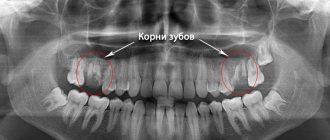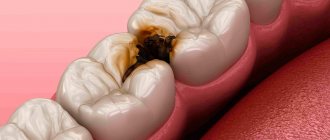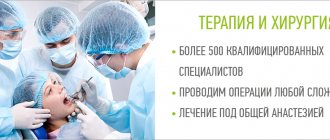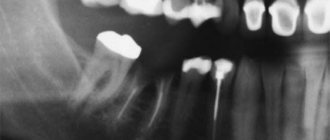Cysts are not a life-threatening pathology, but dentists recommend removing them immediately after diagnosis. The formations can destroy bone tissue and dislodge teeth. It is impossible to eliminate them using conservative methods, so surgery is performed. The modern dental approach is based on a tooth-preserving approach, when the cyst is excised, but the dental element is preserved.
More about the procedure
Cysts most often form near the roots of teeth; without treatment, they can grow rapidly and involve surrounding tissues. Drug therapy is effective at the initial stage, when there is an inflammatory process, but there is no formed capsule. When a tumor appears, surgical treatment is recommended.
Cystectomy is a tooth-preserving operation during which the cystic formation and the mobile part of the root around it are removed. The technique allows you to excise the cyst, which eliminates the possibility of a secondary appearance of a formation in this place. It is performed on both the lower and upper jaws.
Cystotomy and cystectomy in dentistry - what is it and what is the difference
Both operations are used for surgical treatment of cysts. The differences lie in the method of surgery and the final result of the procedure.
Features of the methods:
- During cystectomy, the tumor is radically removed, that is, completely removed. At the last stage, the wound is sutured.
- Cystotomy involves partial removal of the cystic wall and bone. The remaining capsule communicates with the oral cavity. After the procedure, the pressure inside the formation decreases, it flattens, and then gradually resolves.
The choice of method depends on the clinical case. A preliminary X-ray or computed tomography is performed to rule out contraindications.
Advantages and disadvantages of cystotomy:
- advantages - the procedure is easy to perform, low-traumatic, there is no risk of damage to nearby tissues and nerves;
- disadvantages - the duration of postoperative care, as additional cavities are formed, deformations, and jaw defects impair the cleansing of the mouth from microorganisms.
Advantages and disadvantages of cystectomy:
- advantages - complete removal of the capsule, suturing the wound, reparative bone regeneration;
- disadvantages - high trauma, risk of damage to adjacent teeth, nerves, blood vessels, maxillary sinus, accidental removal of a malignant tumor, autolysis of a blood clot in bone tissue cannot be ruled out.
Contraindications
The patient will be denied manipulation if certain conditions are present:
- the root is located in the cyst by more than a third;
- inflammatory process on the mucous membranes, which threatens infection of the soft tissues during the incision;
- destruction of the crown part of the tooth;
- malignant tumors;
- small bone volume, which increases the risk of bone damage.
Also, the patient will be denied surgery if there are standard contraindications for surgery: diabetes, infectious diseases, vascular diseases, pregnancy, etc.
Tooth cyst: historical background
The word “cyst” is of Greek origin (“kystis”) and literally means “bubble.” A dental cyst is a cavity-like tumor-like formation. Previously, when X-rays were not taken, it was extremely difficult to see such formations and, as a rule, dentists encountered them during the extraction of teeth from patients. Thanks to the advent of X-ray diagnostics at the end of the 19th century (1895), it became possible to plan the treatment of dental cysts. And today, if a patient regularly visits the dentist’s office, we can successfully diagnose and eliminate dental cysts at those stages when they do not pose a danger.
Execution technique
Cystectomy is performed under general anesthesia, which not only anesthetizes, but also bleeds the surgical field. Next, the following activities are performed:
- bone exposure;
- gaining access to the cyst;
- removal of the formation (in case of union with the root, its resection is performed);
- filling;
- antibacterial treatment of the bone cavity;
- suturing.
To prevent the appearance of a hematoma, a pressure bandage is applied to the operated area, which is removed after 5-7 days.
Subsequently, the patient is prescribed treatment with anti-inflammatory, antiallergic and painkillers.
Preoperative preparation
During the operation, it is necessary to resect not only the root of the tooth in which the cyst has developed, but also the roots of neighboring teeth, which is why it is necessary to treat them in advance - filling the root canals. As a rule, this happens 2-5 days before the cystectomy. The patient may also be asked to undergo additional examination by visiting the offices of a therapist, cardiologist, etc. The patient will find out exactly what additional examinations are needed in each specific case only at the appointment.
Rehabilitation
The recovery period for soft tissue is up to 2 months, for bone tissue - 5-6 months. The duration depends on the characteristics of the body and compliance with medical recommendations:
- eat soft foods at a comfortable temperature;
- do not eat or drink hot, spicy, salty foods;
- give up alcohol and smoking;
- brush your teeth carefully;
- take all prescribed medications.
Dentists consider cystectomy the most effective and preserving method, which is recommended for everyone in the absence of contraindications.
Recovery period after surgery. Basic recommendations
In the postoperative period, in addition to the basic doctor’s instructions and systematic examination, you should follow the following rules:
- Refrain from eating solid foods for at least a month - nuts, candies, etc.;
- Carefully monitor oral hygiene;
- On the first day you should refrain from eating hot food and drinks;
- Try to reduce the chewing load for at least 1 month;
- After every meal you need to rinse your mouth.
As a rule, if all recommendations are followed, in most patients the healing period of the hole does not exceed 2-2.5 weeks.
Cost of services
Consultation with an implant surgeon 0 rub.
Cystectomy, root apex resection operation RUB 7,000.
Expert of the article you are reading:
Akhmedkhanov Said Rashidovich
Dental surgeon, general dentist, implantologist, orthopedic dentist, dental therapist.
You may also be interested in:
Wisdom tooth removal Tooth extraction Removal of the dental nerve Complex tooth extraction Resection of the apex of the tooth root Removal of an impacted tooth Removal of the tooth root Removal of a dystopic tooth
Show more
Tooth cyst: anatomy
A dental cyst is a benign cavity tumor-like formation that has a membrane and an internal epithelial lining, the cells of which produce fluid. Modern medicine still cannot accurately answer the question of how and where an incipient cyst takes epithelial tissue from. However, most scientists are inclined to believe that it comes from the remnants of the dental epithelium, the so-called islands of Malasse-Astakhov. And it develops as a result of chronic odontogenic inflammation, when microbes enter the jaw bone through the tooth canal. Further development of the process can go in two directions, the result of which are pathologies: an extensive destructive process that does not have a shell - a non-shell formation (such a process is not a cyst), or a dental cyst itself - a shell-like formation.
Possible complications of a dental cyst
As the cyst grows, it can “push aside” nearby anatomical formations, such as the canal of the inferior alveolar nerve, and can disrupt the external contours of the jaw bones (plastic toy syndrome), thereby changing the contours of the face, that is, causing facial asymmetry. It may also involve other neighboring tissues in the pathological process. So, often, retrograde periodontitis develops in the teeth located next to the cyst. And if the cyst grows into the maxillary sinuses, chronic odontogenic sinusitis is formed, which can be asymptomatic for a long time, but, nevertheless, have a detrimental effect on health.
Visit to the dentist without pain
Forget the stress of a botched anesthesia, FDC uses painless pain management techniques.
QuickSleeper is an electronic system that provides simple, fast and comfortable pain relief.
VibraJect is a special attachment. It is an effective way to reduce pain and anxiety during local anesthesia. All this helps reduce patient stress from painful injections and unpleasant visits.
Read more about painless anesthesia with QuickSleeper
What do patients say about apex resection? Reviews are usually only positive!
“Resection of the top of the tooth took about an hour, the operation was performed under pain relief. It didn’t hurt very much near the tooth for about a month. A few months later I had to take an x-ray, the doctor showed that all the tissues had been restored."
“The cyst grew, they told me to remove it, it was a little unpleasant, but quite tolerable - the doctor quickly and accurately carried out the procedure. Everything was restored soon, now it’s completely unnoticeable that there was anything there.”
At Ritsa Dentistry, cyst removal operations are performed by experienced surgeons with extensive experience in performing such procedures. Therefore, you can rely on our professionalism and entrust the treatment of the cyst to our doctors.
When is removal necessary?
As soon as a focus of purulent inflammation appears, doctors give preference to conservative forms of treatment. Having opened the tooth cavity, the doctor cleans it using antibiotics and antiseptic substances.
It is necessary to surgically remove a cyst for the following clinical indications:
- when body temperature rises;
- with swelling of the gums;
- if a tumor appears on the cheek;
- with intense headache;
- when the lymph nodes become enlarged and inflamed;
- when you feel severe weakness, malaise.
The difficulty is that the cyst can develop hidden for a long time, without painful symptoms. As a result, people come to the doctor when swelling and toothache appear. As a result, the only way to help is surgery. The same decision is made when conservative methods do not give the desired effect.
The mechanism of formation and growth of a dental cyst
The cystic cavity, located in the jaw, has external resistance from the surrounding jaw bone. But the epithelial cells of the lining begin to produce fluid, which gradually fills the cavity, creating excess pressure.
This pressure acts on the surrounding bone tissue, causing its gradual peripheral resorption, giving the cyst the opportunity to grow even larger, increase fluid secretion, and therefore put even more pressure on the walls. This is why cysts can grow to very large sizes, sometimes asymptomatically, if not accompanied by periodic inflammation. This may be due to the patient’s good immune status, low pathogenicity of the microflora in the lesion and other factors.










